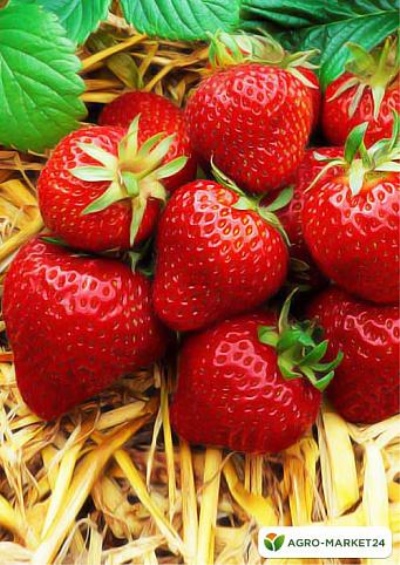
- Authors: France
- Taste: sweet and sour, rich
- The size: medium and large
- Weight: up to 50 g
- Yield rate: high
- Yield: up to 1 kg per bush
- Repairability: Yes
- Ripening terms: early
- Appointment: fresh consumption, processing (juice, jam, jam, etc.)
- Description of the bush: sprawling
Strawberries Mount Everest are very fond of gardeners, as they please with their harvest until late autumn. It is appreciated for ease of maintenance, good taste and unpretentiousness to the soil.
Breeding history of the variety
Strawberry Mount Everest (garden strawberry) was developed in France in the 80s of the last century. The author of the variety is breeder Edward Vinson. The culture was obtained by crossing Evita and Irvina varieties.
Description of the variety
Spreading strawberry bush, 30 to 50 cm high, with a lot of foliage. Leaves are green, trifoliate, pubescent. The plant is characterized by low production in the first year of growth.
Ripening terms
The repairing strawberry variety belongs to the early ripening period.
Growing regions
The Mount Everest variety is grown in the Urals, Siberia, central and southern parts of Russia.
Yield
The variety is characterized by an average yield. Flowering begins in May and continues throughout June. Fruiting period from late June to late autumn, with a short break. Up to 1 kg of berries are harvested from one bush.
Berries and their taste
Medium to large cone-shaped strawberries. The berry mass can reach 50 g. Fruit color is light red. The taste is sweet and sour with a characteristic strawberry aroma. The pulp is dense, juicy. The fruits are good for fresh consumption, as well as for processing into juices, jams, preserves. After deep freezing, they retain their shape and taste. They have good marketability and transportability.
Growing features
The variety is grown indoors or outdoors. The plant can be planted in a checkerboard pattern or in rows. When planting a plant, the distance between the bushes must be from 0.5 to 1.0 m. When planting seedlings, it is necessary to ensure that the root system does not bend up, and the heart is at the level of the soil. After the bushes are planted, they are watered abundantly, the soil is mulched with sawdust, dry grass, and hay.
Strawberry bushes need medium watering intensity. However, the variety does not tolerate dry weather, therefore, in a drought, the plant requires abundant watering from 2-3 times a week.
The plant does not like the neighborhood with weeds, so it is imperative to remove excess vegetation from the garden. An important measure is loosening the soil under the bushes. Frequent loosening improves air permeability to the root system




Site selection and soil preparation
The plant loves open light places, protected from the wind, and partial shade. Optimal soil for the growth of strawberries: clay, sand, black soil. 3 weeks before planting, the soil is dug up, all weeds are removed, organic and mineral fertilizers are applied. For better resistance to infections, the soil is sprayed with fungicides.

Pollination
The plant belongs to bisexual pollination.
Top dressing
In early spring, the bushes are fed with humus. During flowering, the plant is fed with complex mineral fertilizers. Potash fertilizers and ash, diluted in water, are applied towards the end of summer. During the period when strawberries begin to bear fruit, they cannot be fed and fertilized.

One of the important techniques in strawberry care is feeding. Regular fertilization guarantees a rich harvest. There are several different ways to feed strawberries, and each of them is designed for a specific period of plant development. During flowering, fruiting and after it, feeding should be different.
Frost resistance and the need for shelter
The variety is characterized by high winter hardiness, so it does not need shelter. But in regions where winter is harsh, with low snow cover, it is recommended to cover the plant with special materials.

Diseases and pests
The plant has an average resistance to diseases and pests, therefore it is necessary to observe regular preventive measures against infections. If the disease affects the bushes rarely and not much, then you can do without the use of chemicals. In this case, gardeners recommend using a solution of onion husks and potassium permanganate for spraying the bushes. But if the strawberries could not be protected from infection, then you need to spray the bushes with a solution of Bordeaux liquid.

Strawberries are often subject to many dangerous diseases that can seriously undermine their condition. Among the most common are powdery mildew, gray mold, brown spot, anthracnose, and verticillosis. Before buying a variety, you need to inquire about its disease resistance.
Reproduction
Propagate strawberries with a mustache. The plant produces the largest number of them in the first year of growth, therefore, it is recommended to transplant the bushes every three years.For the good development of the mustache, it is necessary to systematically pluck the flowers.

Review overview
Strawberry Mount Everest has established itself as a good remontant variety that has received many positive reviews. But more and more gardeners are abandoning this variety in favor of more modern types of remontant strawberries.


















































































